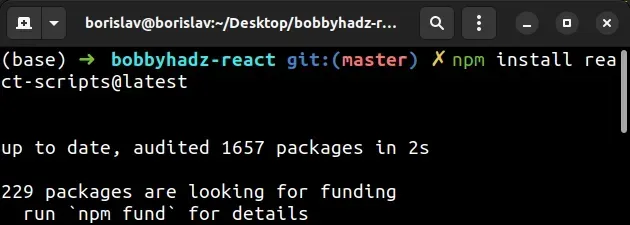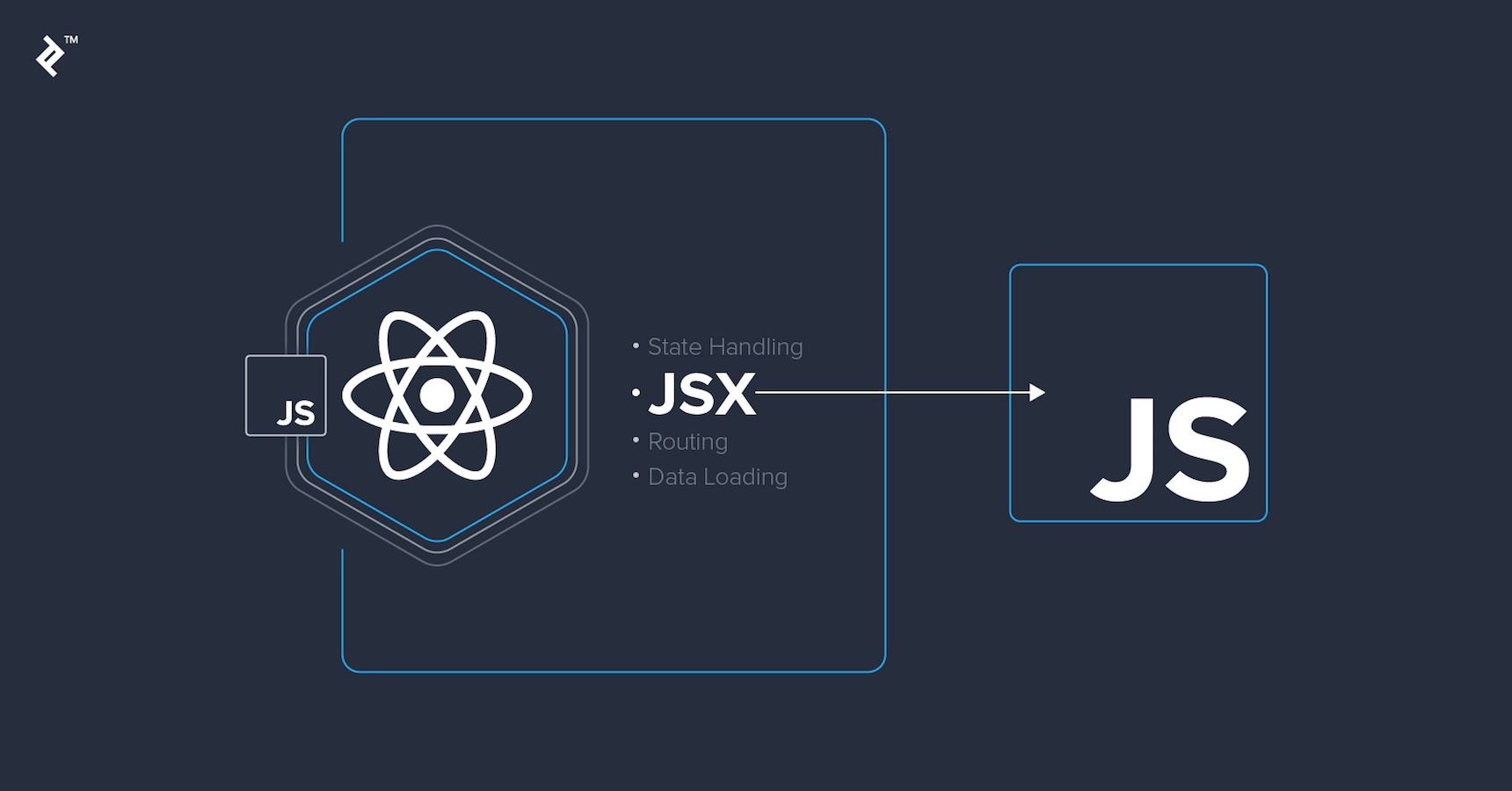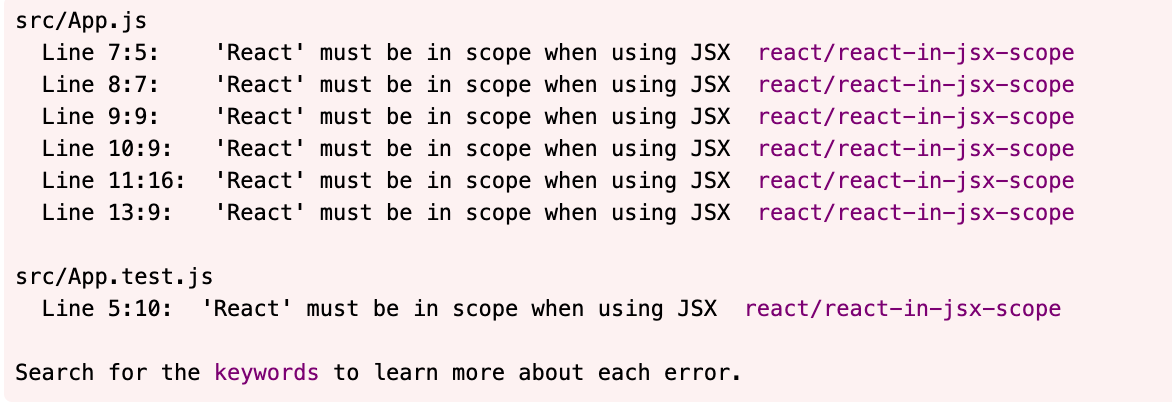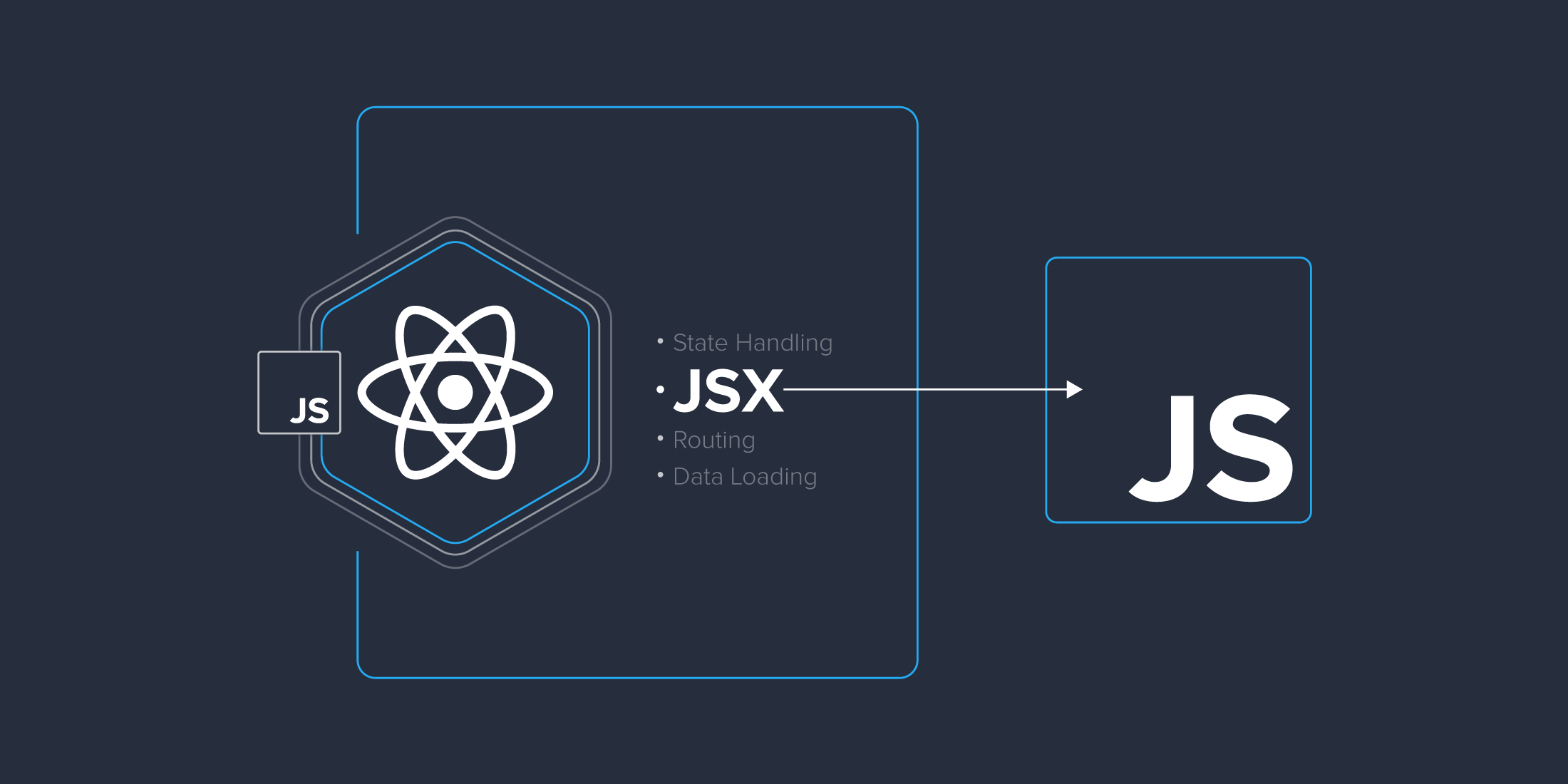‘React’ Must Be In Scope When Using Jsx
Developers often use JSX when working with React, a popular JavaScript library. In this post, we will explore the crucial role of “React” when using JSX, highlighting how the two are closely related.
Understanding React’s Fundamental Concepts
React is a JavaScript library for building user interfaces, known for its simplicity, flexibility, and performance. It enables developers to create reusable UI components that are easy to maintain and update. React follows a declarative, component-based approach, where the UI is divided into separate components, each responsible for a specific functionality.
React’s main concepts include components, state, and props. Components are reusable, self-contained units that encapsulate and manage their own logic and UI. State is an object that stores dynamic data within a component, allowing for real-time updates and rendering. Props, short for properties, are used to pass data from parent to child components, enabling the composition and reusability of components.
JSX Syntax: The Bridge Between React and HTML
JavaScript XML (JSX) is a syntax extension for JavaScript that allows developers to write HTML-like code within JavaScript files. It acts as a bridge between React and HTML, enabling developers to define and render React components in a familiar and intuitive way.
JSX resembles HTML but is not exactly the same. It includes all HTML elements and their attributes, along with additional features such as event handling and dynamic rendering. JSX expressions are enclosed in curly braces {} and can contain JavaScript logic and variables, making it a powerful tool for creating dynamic user interfaces.
Using React Components with JSX
React components are at the core of a React application. They are reusable and independent pieces of code that represent a specific part of the UI. JSX facilitates the integration of React components by allowing developers to define and render them directly within the code.
A JSX component is created by defining a JavaScript function or class that returns JSX code. JSX components can be nested within each other, promoting code reusability and modularity. By using JSX, developers can compose complex user interfaces by combining small, reusable components.
The Power of JSX Expressions
JSX not only enables developers to write HTML-like code but also supports JavaScript expressions within curly braces {}. This allows for dynamic rendering and the execution of complex logic.
By using JSX expressions, developers can conditionally render components, loop through arrays to generate lists, and perform calculations or computations to determine the content or behavior of a component. This flexibility in JSX expressions enhances the interactivity and functionality of web applications built with React.
Transforming JSX into JavaScript with Babel
Babel is a widely used JavaScript compiler that translates modern, syntax-enhanced JavaScript code into versions supported by different browsers. Babel also includes plugins to transform JSX code into plain JavaScript, making it compatible for browsers to understand and interpret.
To use JSX in a project, developers often set up Babel to compile JSX code into JavaScript during the build process. This ensures that the browser can display and render JSX components as intended.
React’s Virtual DOM: The Backbone of JSX
One of React’s primary strengths is its virtual DOM. The virtual DOM is a lightweight copy of the actual DOM, which is the browser’s representation of the HTML structure. The virtual DOM allows React to efficiently update and render changes to the UI without needing to directly manipulate the entire DOM.
JSX leverages React’s virtual DOM to optimize performance. When a JSX component is rendered, React creates a virtual representation of the component’s UI. If changes occur, React efficiently updates the virtual DOM, identifies the minimal required changes, and updates only those specific parts in the actual DOM. This approach improves the performance and speed of React applications.
Leveraging React’s Component Lifecycle with JSX
React components have a lifecycle that defines the sequence of events during their creation, update, and destruction. JSX seamlessly integrates with React’s component lifecycle, allowing developers to control and manipulate components at specific stages.
The component lifecycle methods, such as componentDidMount and componentDidUpdate, can be invoked within JSX components. These methods provide hooks in the component’s lifecycle where developers can perform tasks like fetching data, setting timers, or updating the component’s state.
Event Handling in JSX
Interactivity is crucial in web applications, and JSX provides an easy and efficient way to handle events. JSX supports event handling in React by allowing developers to define event listeners and respond to user interactions.
Event handlers can be added directly within JSX components, using JSX syntax. By attaching event handlers to specific elements or components, developers can define the actions to be performed when an event, such as a button click or form submission, occurs. This enables the creation of highly interactive and responsive web applications.
The Importance of “React” in JSX
React plays a vital role when using JSX. It provides the foundation and functionality for creating dynamic and highly interactive web applications. By combining the power of React with the flexibility of JSX, developers can build complex user interfaces more efficiently.
Some real-world examples of JSX and React in action include creating an e-commerce website with a shopping cart, building a social media feed with dynamic content updates, or developing a real-time chat application. These examples demonstrate how JSX and React work together to enable the creation of feature-rich and interactive web applications.
FAQs:
Q: What is the role of JSX in React?
A: JSX acts as a bridge between React and HTML, allowing developers to write HTML-like code within JavaScript files. It enables the creation and rendering of React components in a familiar and intuitive way.
Q: How does JSX improve web development with React?
A: JSX enhances web development with React by providing a syntax that combines HTML-like code with JavaScript expressions. It enables dynamic rendering, easy component composition, and efficient event handling, making the development process more productive and efficient.
Q: Can JSX be used without React?
A: Although JSX is closely associated with React, it can also be used independently with libraries like Preact, Inferno, or even without any library by using JSX transpilers like Babel. However, the full potential of JSX is realized when used with React, as React provides the necessary functionality and performance optimizations.
Q: How does JSX impact the performance of React applications?
A: JSX, when used with React, leverages React’s virtual DOM to optimize performance. The virtual DOM allows React to efficiently update and render changes to the UI without directly manipulating the entire DOM, resulting in improved performance and speed.
Q: Are there any limitations or drawbacks of using JSX?
A: One limitation of JSX is that it introduces a new syntax that developers need to learn and understand. Additionally, JSX code needs to be transpiled into plain JavaScript using tools like Babel, which adds an extra build step to the development process. However, the benefits of JSX, such as increased productivity and code reusability, outweigh these minor drawbacks.
Q: Can JSX be used in any JavaScript project?
A: JSX can be used in most JavaScript projects, as long as the project is set up to transpile JSX into JavaScript using tools like Babel. However, it is most commonly used in projects built with React and other React-like libraries.
In conclusion, JSX and React are closely related, with JSX serving as a syntax extension that enables the seamless integration of HTML-like code into JavaScript files. React provides the core functionality and optimizations necessary to build dynamic and interactive web applications. By using JSX and React together, developers can enhance their productivity and create feature-rich UIs efficiently.
‘React’ Must Be In Scope When Using Jsx
What Does React Must Be In Scope When Using Jsx?
When working with JSX, you may come across the error message: “React must be in scope when using JSX.” But what does this mean, and how can you address it? In this article, we will explore the concept of scope in the context of React and JSX, and discuss strategies to resolve this error.
Understanding Scope in React and JSX
To comprehend the error message, we need to grasp the concept of “scope” in React and JSX. Scope refers to the accessibility of variables, functions, and objects throughout your code. Within a specific scope, you can access and utilize these elements. React components and libraries, including JSX, also rely on proper scope to function correctly.
By default, JSX assumes that React is in the global scope, available for use without having to import or explicitly declare it. However, this assumption may lead to unexpected issues, such as the error message we mentioned earlier. So, to resolve this error, we need to ensure that React is properly in scope.
Common Causes of the “React Must Be in Scope When Using JSX” Error
There are several common causes that trigger the “React must be in scope when using JSX” error. Understanding these causes will enable you to address the issue promptly. Here are a few typical scenarios:
1. Missing React Import Statement:
One possible cause is forgetting to import React in the component file where JSX is being used. When using JSX, React needs to be imported so that it is in scope. You can resolve this issue by adding the following import statement at the top of your file: `import React from ‘react’;`.
2. Using JSX Without Importing React:
In some cases, you may have imported React but forgot to actually use it in your code. For example, if you declare a component without extending the React.Component class, React will not be in scope. Make sure to properly utilize the React library where necessary.
3. Incorrect File Extension:
Sometimes, the error may occur due to incorrect file extensions. JSX code often resides in “.jsx” or “.tsx” files. If you try to use JSX syntax in another file extension (e.g., “.js” or “.ts”), the error may occur. Ensure that your JSX code resides in a suitable file extension to prevent this issue.
Solving the “React Must Be in Scope When Using JSX” Error
Now that we have understood the causes, let’s explore some strategies to resolve the error.
1. Import React:
Make sure you have imported React using the statement `import React from ‘react’;` at the beginning of your file. This import statement makes React available in the scope of your current file.
2. Use JSX within React Components:
Ensure that you are utilizing JSX within React components. React components need to extend the `React.Component` class, or they should be functional components that use the `React.createElement` function. Confirm that your JSX code is placed correctly within these components.
3. Check File Extensions:
Verify that your JSX code resides in files with the appropriate extensions, such as “.jsx” or “.tsx” for JavaScript and TypeScript, respectively.
FAQs
Q: Why is React’s presence necessary in the scope of JSX usage?
A: JSX is a syntax extension for JavaScript, and React is responsible for converting that JSX into JavaScript functions. If React isn’t in scope, JSX cannot be converted and rendered properly.
Q: Can I use JSX without React?
A: No, JSX relies on React to be converted into regular JavaScript code. React provides the runtime environment and tools necessary for JSX to be executed.
Q: Can I use a different variable name instead of React?
A: Yes, you can import React using any valid variable name you prefer. However, it is a common convention to use the variable name “React” for clarity and consistency with other developers.
Q: Can the error occur in libraries or dependencies too?
A: Yes, libraries and dependencies that use JSX internally must also have React in scope. Ensure that all related files have React properly imported to avoid this error.
Q: Can I use React without JSX?
A: Yes, you can use React without JSX by using the `React.createElement` function to create elements. However, JSX simplifies the syntax and makes code more readable, so it is widely adopted in React development.
In conclusion, when encountering the “React must be in scope when using JSX” error, it is vital to ensure that React is properly imported and used within your components. By taking care of these considerations, you can resolve the error and continue building your React applications seamlessly.
Is Jsx Optional In React?
React is a popular JavaScript library that is widely used for building user interfaces. It allows developers to create reusable UI components and efficiently update and render them when data changes. One of the key features of React is JSX (JavaScript XML), which is a syntax extension allowing developers to write HTML-like code within JavaScript.
JSX simplifies the process of creating and manipulating components by incorporating HTML-like syntax directly into JavaScript. It allows developers to write code that combines both HTML structure and JavaScript logic in a declarative and intuitive manner. JSX syntax is then transpiled into regular JavaScript by tools like Babel, making it compatible with all modern browsers.
While JSX has become an integral part of the React ecosystem, it is important to note that JSX is not mandatory to use React. React can be used without JSX, as it is fundamentally a JavaScript library. In fact, JSX is just a convenient syntax that allows developers to write React code more easily.
When using React without JSX, developers write their components using pure JavaScript or by utilizing alternative templating languages like TypeScript or even plain HTML. However, writing React components without JSX can be quite cumbersome and less readable compared to using JSX.
The main reason why JSX is widely adopted in the React community is that it provides a better developer experience. It allows developers to express component structures and their behavior in a more intuitive way, making the code more readable and maintainable.
JSX also brings several benefits to the table, such as the ability to use JavaScript expressions within the HTML-like syntax. This allows dynamic rendering of components based on different states or data. Additionally, JSX enables the use of browser-based developer tools, like React Developer Tools, which greatly facilitate debugging and inspecting React components.
Another important advantage of JSX is that it seamlessly integrates JavaScript and HTML, making it easier to understand and manipulate the DOM structure. It eliminates the need to switch between separate HTML templates and JavaScript logic, leading to a more coherent and efficient development process.
Many developers argue that JSX is not pure HTML and thus may introduce a learning curve for those who are not familiar with web development. However, JSX is quite similar to HTML, with the main difference being the use of curly braces to embed JavaScript expressions in the markup.
FAQs:
Q: Can I use React without JSX?
A: Yes, JSX is not mandatory when using React. It is a syntax extension that facilitates writing React code, but you can still create React components using pure JavaScript or alternative templating languages.
Q: Is it advisable to use React without JSX?
A: While it is possible to use React without JSX, it is generally advisable to use JSX because it provides a more intuitive and expressive syntax for building React components. JSX enhances code readability and maintainability.
Q: Are there any performance implications of using JSX?
A: JSX itself does not introduce any significant performance overhead. However, the transpilation step from JSX to regular JavaScript may add a minimal amount of overhead. In practice, this overhead is negligible and does not impact the overall performance of React applications.
Q: Can JSX be used outside of React?
A: JSX is not limited to React and can be used in other JavaScript frameworks or libraries. However, JSX is primarily associated with React and is commonly used within the React ecosystem.
Q: Can JSX be used with other JavaScript tools and libraries?
A: Yes, JSX can be used alongside other JavaScript tools and libraries. It can be seamlessly integrated with tools like webpack, Babel, TypeScript, or any other build tool that supports transpiling and transforming JSX syntax.
In conclusion, JSX is not mandatory to use React, but it greatly improves the development experience by providing a more intuitive syntax. It simplifies component creation and manipulation, enables the use of JavaScript expressions within HTML-like syntax, and facilitates debugging and inspecting React components. While it is possible to use React without JSX, it is generally recommended to utilize JSX for an enhanced development process.
Keywords searched by users: ‘react’ must be in scope when using jsx React/jsx-runtime, ESLint, React router-dom, search for the keywords to learn more about each error., Transform reactjs, “plugin:react/jsx-runtime”, Eslint-disable-next-line react, React prop-types eslint
Categories: Top 83 ‘React’ Must Be In Scope When Using Jsx
See more here: nhanvietluanvan.com
React/Jsx-Runtime
React/jsx-runtime is a runtime that optimizes React applications by eliminating the need for explicit imports of React in every file that uses JSX. It achieves this by automatically injecting the required React dependencies into JSX code during the code compilation step. This approach significantly reduces the bundle size and improves performance as it eliminates the redundant imports.
One of the key advantages of using React/jsx-runtime is that it allows developers to write cleaner and more concise code. Instead of having to import React in each file that uses JSX, developers can simply define components and JSX elements without any additional boilerplate. This streamlined workflow speeds up the development process and improves code maintainability.
Another important feature of React/jsx-runtime is its ability to provide forward compatibility with future versions of React. The runtime is designed to be compatible with different versions of React, ensuring that upgrading to newer versions does not break existing code. This makes it easier for developers to keep their codebase up-to-date with the latest React features and improvements.
React/jsx-runtime also provides a performance boost by optimizing the rendering process. It achieves this by using a lightweight runtime implementation of React, which is specifically optimized for production builds. This allows for faster rendering and better overall application performance.
Additionally, React/jsx-runtime introduces automatic component transformations during build-time. This means that certain components and JSX elements can be automatically transformed into more optimized code, resulting in improved performance. This transformation process is done behind the scenes and does not require any additional configuration or changes to the existing codebase.
Furthermore, React/jsx-runtime offers support for static rendering, which allows developers to pre-render components on the server. This is particularly useful for server-side rendering (SSR) applications, as it can significantly reduce the initial load time and improve SEO (Search Engine Optimization). By rendering the components on the server and sending them as HTML to the client, the application can provide a seamless initial user experience.
Now let’s move on to the FAQs section:
Q: Do I need to update my existing codebase to use React/jsx-runtime?
A: No, React/jsx-runtime is designed to be compatible with different versions of React, so you can gradually migrate your codebase without any major changes. However, it is recommended to update to the latest version of React to take advantage of the latest optimizations and improvements.
Q: Can I use React/jsx-runtime with other libraries or frameworks?
A: Yes, React/jsx-runtime can be used alongside other libraries and frameworks. It provides a runtime implementation of React, which can be used independently or in conjunction with other tools like Redux, Vue, or Angular.
Q: Are there any performance trade-offs when using React/jsx-runtime?
A: The use of React/jsx-runtime generally improves performance by reducing bundle size and optimizing rendering. However, it is important to consider the size and complexity of your application and carefully analyze any potential performance impacts. It is always recommended to profile and benchmark your application to ensure optimal performance.
Q: Can I use React/jsx-runtime in both client-side and server-side rendering applications?
A: Yes, React/jsx-runtime can be used in both client-side and server-side rendering applications. It provides support for static rendering, which is particularly useful for server-side rendering (SSR) scenarios. However, it can also be used in client-side rendering for improved performance and code organization.
In conclusion, React/jsx-runtime is a powerful tool for building user interfaces in JavaScript. It simplifies the development process, reduces bundle size, and improves performance. With its forward compatibility, automatic component transformations, and support for static rendering, React/jsx-runtime offers significant benefits to developers. By adopting React/jsx-runtime, developers can write cleaner and more maintainable code while optimizing the rendering process for better overall application performance.
Eslint
Introduction:
In today’s world, JavaScript has become one of the most popular programming languages, powering websites and web applications across the globe. However, as projects grow in complexity and scale, maintaining high code quality becomes essential to ensure efficient and error-free development. This is where ESLint comes into play. ESLint is a JavaScript linter that helps developers enforce coding standards, catch potential errors, and improve code maintainability. In this article, we will explore ESLint in depth and provide answers to frequently asked questions.
What is ESLint?
ESLint is a pluggable and highly configurable static analysis tool for identifying problematic patterns in JavaScript code. It analyzes code statically, allowing developers to catch issues early before running the code. ESLint is built on the concept of rules, which define the coding standards to apply and mistakes to avoid.
Why use ESLint?
Using ESLint as part of your development workflow offers several benefits:
1. Maintaining Code Consistency: ESLint allows project-specific configuration to enforce coding standards at both the individual and team levels. It ensures consistency across the codebase for better readability and collaboration.
2. Catching Potential Bugs: ESLint goes beyond basic syntax checking. It identifies potential issues and bugs that may lead to runtime errors or unexpected behavior, such as unused variables, undefined variables, or missing return statements.
3. Enforcing Best Practices: ESLint can be configured to enforce best practices, coding conventions, and security considerations. It helps in maintaining clean and scalable codebases by preventing common programming pitfalls.
4. Enhancing Code Readability: By adhering to a set of predefined rules, ESLint helps improve code readability, making it easier for developers to understand and maintain the code.
5. Customizability: ESLint’s extensive configuration options enable teams to tailor it to their specific needs. Developers can enable or disable rules, define their own rules, and import community-built plugins for additional functionality.
How does ESLint work?
ESLint operates at the static analysis level and performs rule-based checks on JavaScript code. It parses the JavaScript code into an Abstract Syntax Tree (AST), which represents the code structure. The AST is then traversed to identify patterns and apply rules defined in the ESLint configuration.
ESLint can be run either from the command line or integrated into a code editor or IDE using plugins. It seamlessly integrates with popular development tools like Visual Studio Code, Sublime Text, and Atom, providing real-time feedback and suggestions while coding.
ESLint Configuration:
ESLint configuration is crucial to tailor the linter’s behavior according to the project’s requirements. The configuration file, typically named “.eslintrc” or “.eslintrc.js”, can be placed in the project’s root directory or any other directory within the project. It defines rules, plugins, parser options, and environments to be used by ESLint.
The configuration file supports several formats, including JSON, YAML, and JavaScript. It provides granular control over each rule, allowing them to be enabled or disabled, and even configured with custom options.
ESLint Rules:
ESLint provides a vast collection of predefined rules that cover various aspects of JavaScript programming. These rules cover areas like code conventions, potential errors, best practices, and ECMAScript features. Some commonly used rules include “no-unused-vars” to flag unused variables, “indent” to enforce consistent indentation, and “no-console” to disallow the use of console methods.
Developers can enable, disable, or customize these rules based on the project’s needs. Enabling a rule causes ESLint to report any violations as errors or warnings, making it an invaluable tool in preventing common coding mistakes.
ESLint Plugins:
ESLint’s plugin system allows the community to extend its functionality and cover specific use cases. Plugins are published packages that can be easily imported into an ESLint configuration. These community plugins provide additional rules and configurations beyond the default set.
Whether it’s enforcing React coding conventions or ensuring JavaScript code compatibility with a specific browser, ESLint plugins offer specialized rule sets that cater to different development environments and frameworks.
FAQs:
Q1. Can ESLint be used with other programming languages?
No, ESLint is primarily designed for JavaScript. However, there are linters available for other languages, such as TSLint for TypeScript, stylelint for CSS, and flake8 for Python.
Q2. How can I integrate ESLint into my development workflow?
ESLint can be integrated into popular code editors or IDEs using plugins. Most editors provide extensions to handle ESLint integration and display real-time feedback while writing code. Additionally, ESLint can be run from the command line as part of the build process or continuous integration pipeline.
Q3. Can I use ESLint without a configuration file?
Yes, ESLint provides a default set of rules out-of-the-box for quick setup. However, it is highly recommended to create a configuration file to customize and fine-tune the rules according to your project’s needs.
Q4. Can ESLint automatically fix the identified issues?
Yes, ESLint offers an auto-fix feature that can automatically fix certain rule violations. However, not all issues can be fixed automatically, and manual intervention is often required.
Q5. Are ESLint rules widely accepted in the JavaScript community?
Yes, ESLint has gained significant popularity and is widely adopted within the JavaScript community. It is actively maintained and frequently updated to adapt to the evolving JavaScript landscape.
Conclusion:
ESLint is an indispensable tool for maintaining high code quality and catching potential issues in JavaScript projects. By enforcing coding standards, preventing bugs, and enhancing code readability, ESLint ensures a smoother development process and improves the overall quality of JavaScript codebases. With its flexibility and integration capabilities, ESLint is an invaluable tool for developers striving to deliver efficient and error-free JavaScript code.
React Router-Dom
What is React Router-DOM?
React Router-DOM is a component-based routing library used in web applications developed with React. It builds on top of the React Router library and provides a set of higher-order components (HOC) and hooks to enable routing functionality in React applications. It uses a declarative approach to define the routing configuration and renders the appropriate components based on the current URL.
Setting Up React Router-DOM
To get started with React Router-DOM, you need to install it as a dependency in your React project. You can use npm or yarn to install it by running the following command:
“`
npm install react-router-dom
“`
Once the installation is complete, you can import the necessary components from the package. To configure the routing, you will typically wrap your entire application with the `BrowserRouter` component, which provides the necessary context for the routing functionality to work. Here’s an example of setting up React Router-DOM:
“`jsx
import React from ‘react’;
import { BrowserRouter as Router, Switch, Route } from ‘react-router-dom’;
function App() {
return (
);
}
export default App;
“`
In this example, the `BrowserRouter` wraps the `Switch`, which is responsible for rendering the appropriate component based on the current URL. Inside the `Switch`, we define multiple `Route` components, each representing a different route. The `exact` attribute is used to match the exact URL path, and the `component` attribute specifies the component to render for that particular route. The `NotFound` component acts as a fallback for any undefined routes.
Navigating Between Routes
React Router-DOM provides a set of components and hooks to handle navigation between routes. The most commonly used component for this purpose is the `Link` component. It renders an anchor tag with an `href` attribute that corresponds to the specified route. When clicked, it triggers the navigation to the target route without causing a full page reload.
“`jsx
import React from ‘react’;
import { Link } from ‘react-router-dom’;
function Navbar() {
return (
);
}
export default Navbar;
“`
In the above example, the `Link` component is used to create navigation links for the different routes. The `to` attribute specifies the target route, which should be matched with the corresponding `Route` component defined in the routing configuration.
Handling Dynamic Routes
React Router-DOM also supports dynamic routing, where certain portions of the URL can be dynamic and passed as parameters to the rendered component. This is achieved using the `Route` component’s `path` attribute by specifying a placeholder.
“`jsx
“`
In the above example, the `:id` placeholder will match any value passed in as a parameter after `/user/`. For example, `/user/1` will render the `User` component with the `id` parameter set to `1`. The value of the parameter can be accessed in the rendered component using the `useParams` hook.
“`jsx
import React from ‘react’;
import { useParams } from ‘react-router-dom’;
function User() {
const { id } = useParams();
return
;
}
export default User;
“`
In the above example, the `useParams` hook is used to retrieve the parameter values from the URL. The `id` parameter is then rendered as part of the component.
FAQs about React Router-DOM:
1. How does React Router-DOM differ from React Router?
React Router is the core routing library for React, while React Router-DOM is a higher-level implementation specifically designed for web applications. React Router-DOM provides additional features and convenience components like `Link` for web-specific routing.
2. Can I use React Router-DOM with other state management libraries like Redux?
Yes, React Router-DOM can be used with any state management library, including Redux. It seamlessly integrates with the existing state management solution in your React application.
3. How can I handle authentication and private routes with React Router-DOM?
React Router-DOM provides a component called `PrivateRoute` that allows you to protect specific routes and only allow authenticated users to access them. You can implement authentication logic inside this component to render the respective components or redirect to a login page.
4. Is it possible to nest routes in React Router-DOM?
Yes, React Router-DOM supports nested routes. You can define routes inside components and use the `Route` component to specify the nested routes.
5. Can I use React Router-DOM in a React Native application?
No, React Router-DOM is specifically designed for web applications. For React Native applications, you can use the React Navigation library, which provides similar routing functionality optimized for mobile apps.
In conclusion, React Router-DOM is a powerful library that simplifies routing in React applications. By using its components and hooks, you can easily implement navigation, handle dynamic routes, and create a smooth user experience. The flexibility and versatility of React Router-DOM make it an essential tool for building complex web applications with React.
Images related to the topic ‘react’ must be in scope when using jsx

Found 16 images related to ‘react’ must be in scope when using jsx theme


























Article link: ‘react’ must be in scope when using jsx.
Learn more about the topic ‘react’ must be in scope when using jsx.
- How To Fix “React Must Be in Scope When Using JSX” Error
- ‘React’ must be in scope when using JSX … – Stack Overflow
- ‘React’ must be in scope when using JSX react … – bobbyhadz
- Why do React need to be in scope for JSX ? – DEV Community
- How To Fix “React Must Be in Scope When Using JSX” Error
- React Without JSX
- How to Use JSX Without React – Better Programming
- The Uncomplicated Guide To JSX Syntax – Kinsta®
- eslint-plugin-react/docs/rules/react-in-jsx-scope.md at master
- Must React Be in Scope When Using JSX? – Upmostly
- JSX In Depth – React
- react must be in scope when using jsx
- ‘react’ must be in scope when using jsx – AI Search Based Chat
See more: https://nhanvietluanvan.com/luat-hoc